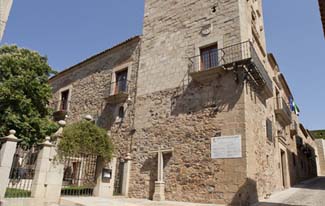
Photos courtesy of Parador de Cáceres
Contact
Calle Ancha, 6
10003 Cáceres (Cáceres)
Tel: ++34 927 21 17 59
Fax: ++34 927 21 17 29
Official parador website
Reserve with Booking.com
39 rooms
Double rooms: 110–288 euros
Single rooms: 80% of double
room rate.
Rates include tax. Breakfast extra.
Free Wi-Fi
Open: all year
Cáceres is in the north central part of Extremadura on the crossroads of routes N-521 and N-630. If driving to the parador, you’re allowed to cross the traffic barrier in the old town. Ring the police at the barrier intercom, and the barrier will open. Cáceres is also served by train.
Nearby: exploring the old town of Cáceres; golf; horseback riding; hiking
This fine stone parador is actually composed of a palace and three connecting noble houses, giving a somewhat labyrinthine appearance to the interiors. Where you least expect it, a corridor opens onto a room or another hallway.
Wood-coffered ceilings look down on the public areas, distinguished by leaded glass windows, elegant wood furniture, and fine carvings. Delightful patios are filled with potted plants and flowers, while wrought-iron touches and coats of arms grace the walls. Trickling fountains give an air of relaxation.
A recent renovation has changed the look of the guest rooms. In place of the old world character is modern décor in subdued shades of white and gray. It works though, especially with the tiled floors and the occasional vaulted ceiling. All rooms are air-conditioned, and comfy, with large, modern bathrooms.
Enjoy a before-dinner aperitif in the bar at a table set into a nook overlooking the garden. During warm months, dining is on an outside patio, delicately scented by orange trees. Menu specialties are reflective of the hearty fare you find in Extremadura: roast suckling pig, roast kid, and Iberian pork loin with Cesar cheese.
![]() The old city of Cáceres is a UNESCO World Heritage site.
The old city of Cáceres is a UNESCO World Heritage site.